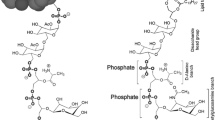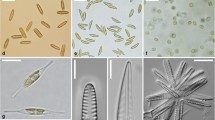Abstract
Antifreeze proteins are a group of proteins that allow organisms to survive in subzero environments. These proteins possess thermal hysteresis and ice recrystallization inhibition activities. In the present study, we demonstrated the efficiency of a recombinant antifreeze protein from the Arctic yeast Leucosporidium sp. AY30, LeIBP, in cryopreservation of the marine diatom Phaeodactylum tricornutum, which is one of the classical model diatoms and has most widely been studied with regard to its ecology, physiology, biochemistry, and molecular biology. P. tricornutum cells were frozen by either a fast or two-step freezing method in freezing medium containing 10 % dimethyl sulfoxide, glycerol, propylene glycol, and ethylene glycol, respectively, with or without LeIBP supplement. When cells were frozen using the two-step freezing method, cell survival was significantly increased and statistically the same as that of unfrozen native cells in the presence of 0.1 mg/ml LeIBP in 10 % propylene glycol or 10 % ethylene glycol at day 11 of post-thaw culture. In the presence of LeIBP, the concentration of chlorophyll a was dramatically increased to 14-, 48-, 1.6-, and 8.8-fold when cells were frozen in freezing medium containing dimethyl sulfoxide (DMSO), glycerol, propylene glycol (PG), and ethylene glycol (EG), respectively. Scanning electron microscopy observations demonstrated that the cells were also successfully preserved and epitheca or hypotheca were not deformed. These results demonstrate that LeIBP was successfully applied to improve cryopreservation of the marine diatom P. tricornutum.



Similar content being viewed by others
References
Smetacek, V. (1999). Protist, 150, 25–32.
Depauw, F. A., Rogato, A., Ribera d’Alcala, M., & Falciatore, A. (2012). Journal of Experimental Botany, 63, 1575–1591.
De Martino, A., Meichenin, A., Shi, J., Pan, K., & Bowler, C. (2007). Journal of Phycology, 43, 992–1009.
Howland, R. J., Tappin, A. D., Uncles, R. J., Plummer, D. H., & Bloomer, N. J. (2000). Science of the Total Environment, 251–252, 125–138.
Borowitzka, M. A., Chiappino, M. L., & Volcani, B. E. (1977). Journal of Phycology, 13, 162–170.
Borowitzka, M. A., & Volcani, B. E. (1978). Journal of Phycology, 14, 10–21.
Wilson, D. P. (1946). Journal of the Marine Biological Association of the UK, 26, 235–270.
De Martino, A., Bartual, A., Willis, A., Meichenin, A., Villazan, B., Maheswari, U., & Bowler, C. (2011). Protist, 162, 462–481.
Day, J. G., & DeVille, M. M. (1995). Methods in Molecular Biology, 38, 81–89.
Day, J. G., Fleck, R. A., & Benson, E. E. (2000). Journal of Applied Phycology, 12, 369–377.
Round, F. E., Crawford, R. M. & Mann, D. G. (1990). The diatoms: biology and morphology of the genera. 1 ed. Cambridge University Press.
Day, J. G., & Brand, J. J. (2005). In R. A. Anderson (Ed.), Algal culturing techniques (pp. 165–187). New York: Academic Press.
Day, J. G. (2007). In J. G. Day & G. N. Stacey (Eds.), Cryopreservation and freeze-drying protocols (pp. 141–151). Totowa: Humana Press.
Lee, J. J., & Soldo, A. T. (1992). Protocols in protozoology (ed). Lawrence, Kansas: Wiley-Blackwell.
Morris, G. J. (1978). British Phycological Journal, 13, 15–24.
Bodas, K. C., Diller, K. R., & Brand, J. J. (1995). Cryo Letters, 16, 267–274.
Day, J. G., Benson, E. E., Harding, K., Knowles, B., Idowu, M., Bremner, D., Santos, L., Santos, F., Friedl, T., Lorenz, M., Lukesova, A., Elster, J., Lukavsky, J., Herdman, M., Rippka, R., & Hall, T. (2005). Cryo Letters, 26, 231–238.
Hubálek, Z. (2003). Cryobiology, 46, 205–229.
Franks, F. (1985). Biophysics and biochemistry at low temperatures (ed). New York: Cambridge University Press.
Taylor, R., & Fletcher, R. (1999). Journal of Applied Phycology, 10, 481–501.
Fuller, B. J. (2004). Cryo Letters, 25, 375–388.
Adler, S., Pellizzer, C., Paparella, M., Hartung, T., & Bremer, S. (2006). Toxicology in Vitro, 20, 265–271.
Iwatani, M., Ikegami, K., Kremenska, Y., Hattori, N., Tanaka, S., Yagi, S., & Shiota, K. (2006). Stem Cells, 24, 2549–2556.
Thaler, R., Spitzer, S., Karlic, H., Klaushofer, K., & Varga, F. (2012). Epigenetics, 7, 635–651.
DeVries, A. L., & Wohlschlag, D. E. (1969). Science, 163, 1073–1075.
Lee, J. K., Park, K. S., Park, S., Park, H., Song, Y. H., Kang, S. H., & Kim, H. J. (2010). Cryobiology, 60, 222–228.
Raymond, J. A., Fritsen, C., & Shen, K. (2007). FEMS Microbiology Ecology, 61, 214–221.
Atici, O., & Nalbantoglu, B. (2003). Phytochemistry, 64, 1187–1196.
Duman, J. G., & Olsen, T. M. (1993). Cryobiology, 30, 322–328.
Gilbert, J. A., Davies, P. L., & Laybourn-Parry, J. (2005). FEMS Microbiology Letters, 245, 67–72.
Graether, S. P., & Sykes, B. D. (2004). European Journal of Biochemistry, 271, 3285–3296.
Yeh, Y., & Feeney, R. E. (1996). Chemical Reviews, 96, 601–618.
Chao, H., Davies, P. L., & Carpenter, J. F. (1996). Journal of Experimental Biology, 199, 2071–2076.
Kang, J. S., & Raymond, J. A. (2004). Cryo Letters, 25, 307–310.
Lee, S. G., Koh, H. Y., Lee, J. H., Kang, S. H., & Kim, H. J. (2012). Applied Biochemistry and Biotechnology, 167, 824–834.
Arav, A., Rubinsky, B., Seren, E., Roche, J. F., & Boland, M. P. (1994). Theriogenology, 41, 107–112.
Koushafar, H., & Rubinsky, B. (1997). Urology, 49, 421–425.
Matsumoto, S., Matsusita, M., Morita, T., Kamachi, H., Tsukiyama, S., Furukawa, Y., Koshida, S., Tachibana, Y., Nishimura, S., & Todo, S. (2006). Cryobiology, 52, 90–98.
Payne, S. R., Oliver, J. E., & Upreti, G. C. (1994). Cryobiology, 31, 180–184.
Lee, J. H., Lee, S. G., Do, H., Park, J. C., Kim, E., Choe, Y. H., Han, S. J., & Kim, H. J. (2013). Applied Biochemistry and Biotechnology, 97, 3383–3393.
Guillard, R. R. L. (1975). In W. L. Smith & M. H. Chanley (Eds.), Culture of marine invertebrate animals (pp. 29–60). New York: Springer.
Park, K. S., Lee, J. H., Park, S. I., Do, H., Kim, E. J., Kang, S. H., & Kim, H. J. (2012). Cryobiology, 64, 286–296.
Welschmeyer, N. A. (1994). Limnology and Oceanography, 39, 1985–1992.
Mitbavkar, S., & Anil, A. C. (2006). Cryobiology, 53, 143–147.
Polge, C., Smith, A. U., & Parkes, A. S. (1949). Nature, 164, 666.
Day, J. G., Watanabe, M. M., Morris, G. J., Fleck, R. A., & McLellan, M. R. (1997). Journal of Applied Phycology, 9, 121–127.
Kim, H. J. (2011). Ocean and Polar Research, 33, 303–308.
Tanniou, A., Turpin, V., & Lebeau, T. (2012). Cryobiology, 65, 45–50.
McGrath, M. S., Daggett, P. M., & Dilworth, S. (1978). Journal of Phycology, 14, 521–525.
Carpenter, J. F., & Hansen, T. N. (1992). Proceedings of the National Academy of Sciences of the United States of America, 89, 8953–8957.
Acknowledgments
This work was supported by a grant from the Korea Polar Research Institute (PE14070).
Author information
Authors and Affiliations
Corresponding author
Rights and permissions
About this article
Cite this article
Koh, H.Y., Lee, J.H., Han, S.J. et al. Effect of the Antifreeze Protein from the Arctic Yeast Leucosporidium sp. AY30 on Cryopreservation of the Marine Diatom Phaeodactylum tricornutum . Appl Biochem Biotechnol 175, 677–686 (2015). https://doi.org/10.1007/s12010-014-1337-9
Received:
Accepted:
Published:
Issue Date:
DOI: https://doi.org/10.1007/s12010-014-1337-9




